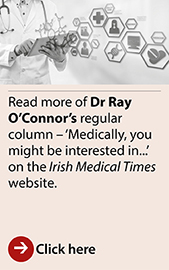Dr Ray O’Connor , 2025-04-15 07:30:00
Dr Ray O’Connor takes a look at the latest clinical articles on the subject of hypertension
Hypertension (Part 1)
Hypertension can be effectively treated with antihypertensive medication, which has been proven to lower the risk of stroke and cardiovascular diseases across all age groups. Even in patients older than 80 years, trials have shown that antihypertensive treatment reduces the risk of cardiovascular disease and all-cause mortality. Recently however, there has been significant changes in our understanding of the management of hypertension.
The beneficial effects on non-drug interventions are becoming clearer, there has been a change in blood pressure (BP) targets, an awareness of the importance of methodology in measuring BP, trials of low-dose antihypertensive drug combinations and deprescribing, especially in older age groups.

Dr Ray O’Connor
Firstly, how do we actually measure BP? Does it matter? In fact, it matters a lot. This crossover randomized clinical trial1 recruited adults between the ages of 18 and 80 years in the US in 2023.
Participants were randomly assigned to sets of triplicate BP measurements with the arm positioned in three ways: (1) supported on a desk (desk 1; reference), (2) hand supported on lap (lap), and (3) arm unsupported at the side (side). To account for intrinsic BP variability, all participants underwent a fourth set of BP measurements with the arm supported on a desk (desk 2).
The primary outcomes were the difference in differences in mean systolic BP (SBP) and diastolic BP (DBP) between the reference BP (desk 1) and the 2 arm support positions (lap and side). The findings were as follows. Lap and side positions resulted in statistically significant higher BP readings than desk positions, with the difference in differences as follows: lap, SBP Δ 3.9 mmHg and DBP Δ 4.0 mmHg; and side, SBP Δ 6.5 mmHg and DBP Δ 4.4 mmHg.
The patterns were generally consistent across subgroups. The conclusion was that commonly used arm positions (lap or side) resulted in substantial overestimation of BP readings and may lead to misdiagnosis and overestimation of hypertension.
The European Society of Cardiology (ESC) have just published their updated guideline for the management of hypertension, focusing on drug treatment.2
Firstly, they now classify BP readings as follows: non-elevated (office BP < 120/70 mmHg), elevated BP (office BP 120–139/70–89 mmHg), and hypertension (office BP ≥140/90 mmHg). Regarding the initiation of BP-lowering pharmacotherapy, the recommendations are as follows.
Lifestyle measures remain vital for effective BP-lowering at all stages of treatment. Some individuals require initiation of pharmacotherapy to reduce cardiovascular disease (CVD) risk. The new guideline recommends BP-lowering pharmacotherapy for all adults with confirmed hypertension (Class I). BP-lowering pharmacotherapy is now also recommended for persons with elevated BP and sufficiently high CVD risk who have repeated BP ≥130/80 mmHg despite three months of lifestyle measures.
First line BP-lowering pharmacotherapy: Angiotensin converting enzyme inhibitors or angiotensin receptor blockers, dihydropyridine calcium channel blockers, and thiazide or thiazide-like diuretics are the recommended first line BP-lowering medications. While beta-blockers are not considered as first line, they are recommended in combination with first line medications when there is a compelling indication.
The guidelines recommend upfront two-drug low-dose combinations for the majority of patients with hypertension, preferably administered as single pill combinations. Three-drug low-dose treatment is the next step, before up-titrating to maximally tolerated doses. Initial monotherapy is an option for individuals ≥85 years, persons with moderate/severe frailty, symptomatic orthostatic hypotension, and for those with sufficiently high CVD risk. The new guidelines recommend a systolic BP target of 120–129 mmHg for most adults receiving pharmacotherapy.
 When not tolerated, targeting a systolic BP ‘as low as reasonably achievable’ is recommended instead. The diastolic BP target is 70-79 mmHg. For individuals with resistant hypertension, spironolactone (eplerenone if not tolerated) is the preferred option, followed by beta blockers and then, additional medications (e.g. alpha blockers, hydralazine).
When not tolerated, targeting a systolic BP ‘as low as reasonably achievable’ is recommended instead. The diastolic BP target is 70-79 mmHg. For individuals with resistant hypertension, spironolactone (eplerenone if not tolerated) is the preferred option, followed by beta blockers and then, additional medications (e.g. alpha blockers, hydralazine).
How effective are lifestyle measures in lowering elevated BP? This systematic review3 aimed to evaluate the dose-dependent effects of aerobic exercise SBP and DBP and haemodynamic factors in adults with hypertension.
The analysis of 34 trials with 1,787 participants indicated that each 30 min/week aerobic exercise reduced SBP by 1.78 mmHg and DBP by 1.23 mmHg. A nonlinear dose-dependent decrement was seen on SBP and DBP, with the greatest decrement at 150 min/week (7.23 mmHg, for SBP and -5.58 mmHg, for DBP). The conclusion is that aerobic exercise can lead to a large and clinically important reduction in blood pressure in a dose-dependent manner, with the greatest reduction at 150 min/week.
Isometric exercise refers to a sustained muscular contraction in which the length of the muscle does not change. This was an expert-informed review4 on the role of isometric exercise training in the prevention and treatment of arterial hypertension, covering the efficacy, prescription protocols, evidence quality and certainty, acute cardiovascular stimulus, and physiological mechanisms underpinning its anti-hypertensive effect.
The authors concluded that data from prospective randomised controlled trials and meta-analyses indicate that isometric exercise training is capable of producing blood pressure reductions greater than that observed following the currently recommended exercise guidelines and possibly even greater, or at least similar to that of standard anti-hypertensive monotherapy.
References:
- Liu H et al. Arm Position and Blood Pressure Readings The ARMS Crossover Randomized Clinical Trial. JAMA Intern Med. doi:10.1001/jamainternmed.2024.5213 Published online October 7, 2024.
- McCarthy C et al. 2024 ESC Guidelines for the management of elevated blood pressure and hypertension: what is new in pharmacotherapy? European Heart Journal – Cardiovascular Pharmacotherapy (2025) 11 , 7–9 https://doi.org/10.1093/ehjcvp/pvae084
- Ganieh B et al. Effects of aerobic exercise on blood pressure in patients with hypertension: a systematic review and dose-response meta-analysis of randomized trials. Hypertens Res. 2024 Feb;47(2):385-398. doi: 10.1038/s41440-023-01467-9
- Edwards J et al. Isometric Exercise Training and Arterial Hypertension: An Updated Review. Sports Medicine (2024) 54:1459–1497 https://doi.org/10.1007/s40279-024-02036-x

